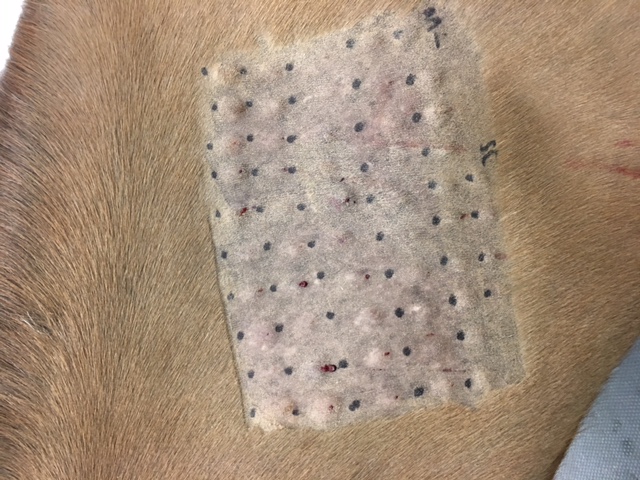Intradermal Skin Testing Information
 When your horse has been referred to us for intradermal skin testing, it is to investigate and identify possible triggers for allergic skin disease. We can’t test for all allergens that a horse comes into contact with in his or her environment, but what we can do is test for most commonly encountered ones and aim to exclude
When your horse has been referred to us for intradermal skin testing, it is to investigate and identify possible triggers for allergic skin disease. We can’t test for all allergens that a horse comes into contact with in his or her environment, but what we can do is test for most commonly encountered ones and aim to exclude
or control exposure to these. In some cases we can use the testing information to create a tailor-made desensitisation vaccine for your horse which aims to gradually increase a horse’s tolerance of particular allergens. An outline of what will happen during the testing is listed below.
It is important that any steroid treatment is stopped a week prior to testing. Occasionally, treatment can be given closer to the testing day but this will be advised on a case by case basis.
The testing process & what to expect
- We will take a history from your vet regarding how many episodes your horse has had, response to
treatment and if the signs are mainly urticaria (skin lumps) or pruritus (itching). If you have any information
about what management changes you have tried and if they have made any difference to the symptoms
please let us know when you leave your horse with us.
- We ask that your horse arrives either the night before testing or between 8-8.30am on the day of testing so
he/she is settled before the test is started.
- Before testing, we clip a large area of hair, usually on one side of the neck. After cleaning, a grid or spots
are then drawn on the neck so we know the location of each allergen. We do remove the marker pen
after the testing has finished but there may be some evidence of it for a few days, especially in light
coloured horses.
- Very small volumes of approximately 50 allergens are then carefully injected within the layers of the skin
(an “intradermal” injection). Although the needles are very small and usually tolerated well, we do often
give some sedation for this part of the testing. We also inject a positive control (histamine) and a negative
control (saline) to which we can compare the individual reactions.
- We then carefully measure the response to each allergen at 30 minutes, 4 hours and 24 hours. We assess
the size and firmness of each skin wheal that appears in response to the allergen and compare them to the positive and negative control.
- On the whole the testing is very safe but on rare occasions marked reactions can occur. We therefore
monitor your horse closely during the testing process.
- From the start of testing until the 24 hour reading your horse will have to be stabled in an empty stable
(with matting) and we withhold food until after the 4 hour reading. This is so potential feed or bedding
allergen does not interfere with the results.
- After 24 hours your horse can be discharged and we will contact you with the results of the testing.
- We will then contact you again within 48 hours to fully discuss the results and will send you a report. This
report will advise on management changes to limit exposure to the allergens identified on testing and
advise if your horse is a suitable candidate or not for the desensitisation vaccine programme.
- If a desensitisation vaccine is appropriate, an individual vaccine is made for your horse based on the
allergens it has responded to. The horse is then injected at home (by the owner) based on the schedule
provided (Day 1,15, 29, 43, 64 and 85) in the adjustment period, and then every 3 weeks after that.
We hope this helps you to understand what to expect but if you have any queries then please
contact the hospital on 01453 811867 or referrals@bwequinevets.co.uk and one of our vets will
be happy to talk to you
 When your horse has been referred to us for intradermal skin testing, it is to investigate and identify possible triggers for allergic skin disease. We can’t test for all allergens that a horse comes into contact with in his or her environment, but what we can do is test for most commonly encountered ones and aim to exclude
When your horse has been referred to us for intradermal skin testing, it is to investigate and identify possible triggers for allergic skin disease. We can’t test for all allergens that a horse comes into contact with in his or her environment, but what we can do is test for most commonly encountered ones and aim to exclude